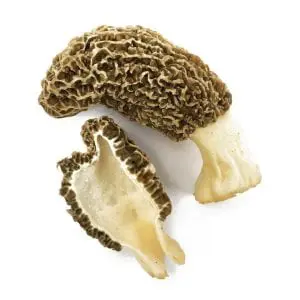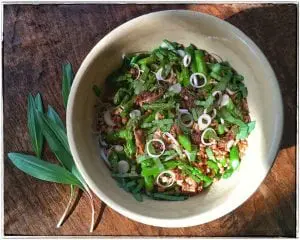By Joe Dizney
After the endless grey days of winter and early spring, when change happens at a glacial pace, spring is a rapid-fire feast for the senses. The fragrance of viburnums is replaced overnight by the perfume of lilacs and the garden and woods fill with transient treats. The delicate trilliums are floral cues that wonders are afoot — Asparagus! Ramps! Morels! — each with a sinfully abbreviated season of three to four weeks. The time is now.
Ramps, also known as wild garlic or wood leeks, were the first of these I noticed, and my neighbor and I have been harvesting a slope of them for weeks. The whole plant is edible, and the flavor and smell is a pungent combination of onions and garlic.

At the Cold Spring Farmers’ Market on April 29, Madura Farms offered the first morels I’d seen locally and prompted this week’s recipe. And glory-of-glories, three days later, while walking my dog, I stumbled upon my first wild morels. (Last year I logged them in around May 20.) Commonly called yellow or golden morels, they are found in forests, orchards, yards and gardens, usually near deciduous trees, particularly ash, sycamores, tulip trees, aged apple trees or dying elms.
Morels are a relatively safe bet as most of the notoriously poisonous varieties — the amanitas and such — are “in season” much later. Their only lookalike is the “false morel,” which is nominally edible but requires specific preparation and parboiling to avoid gastric complications. (In fact, all wild-foraged mushrooms should be cooked, and by no means should you attempt an amateur identification.)
Given these caveats, there are few gastronomic partnerships as compatible as the meaty earthiness of morels and the pungent richness of ramps. Unless, of course, you add the delicate vegetal sweetness of, say, asparagus, which is in season now and can be culled in the wild (I’ve found large specimens along a trail on Mt. Beacon).

In this recipe, briefly cooked asparagus and sautéed mushrooms are tossed with raw ramps, spring onions and crunchy cooked farro, an Italian grain made from dried spelt berries. Although it may sound exotic, Bob’s Red Hill brand is available at Foodtown or Nature’s Pantry.
If you want to get a bit wilder, substitute fiddleheads (also just appearing) for the asparagus. Or, if you’re hesitant, substitute cultivated shitake mushrooms (also available at Foodtown and most markets) for the morels, and green onion tops for the ramps.
Just don’t wait too long: this moment won’t last forever.
Farro Salad with Asparagus, Ramps and Morels
Serves 6
2 cups cooked farro (1 cup dry, prepared to package directions)
½ lb. morels (substitute shitakes), cleaned and quartered
2 medium shallots, minced fine
1 lb. fresh asparagus (tough ends removed)
¼-to-½ lb. sustainably harvested ramps, cleaned and sliced into a thin (¼ in.) chiffonade*
4 large (¾-to-1-in. bulbs) spring green onions (scallions), bulbs only, sliced thin*
1 tbsp. fresh lemon juice
1 tbsp. white wine vinegar
1 tsp. Dijon mustard
Salt and freshly ground black pepper
Extra virgin olive oil (about 1 cup total)
Heat a couple of tablespoons of olive oil in a medium sauté pan over medium-high heat. Cook one tablespoon of the minced shallots until just softened and add the morels, cooking for about 5 minutes to remove any moisture. (Add a splash of soy sauce to them while cooking if it’s handy for extra umami.) Remove from heat and reserve.
Bring a wide pot or skillet with at least 3 to 4 inches of salted water to a boil, and cook the asparagus spears for a mere 2 minutes. Immediately drain them and plunge into an ice water bath to stop cooking. Drain thoroughly; bias cut spears into 2-to-3-inch pieces and reserve.
Make vinaigrette, whisking the lemon juice, vinegar, remaining minced shallot, salt and pepper to taste with ½ cup of the olive oil.
Toss all the ingredients together lightly to mix, adding extra oil if necessary. Correct the seasoning if necessary and serve.
*Reserve the onion greens for another use or substitute them for the ramps.

